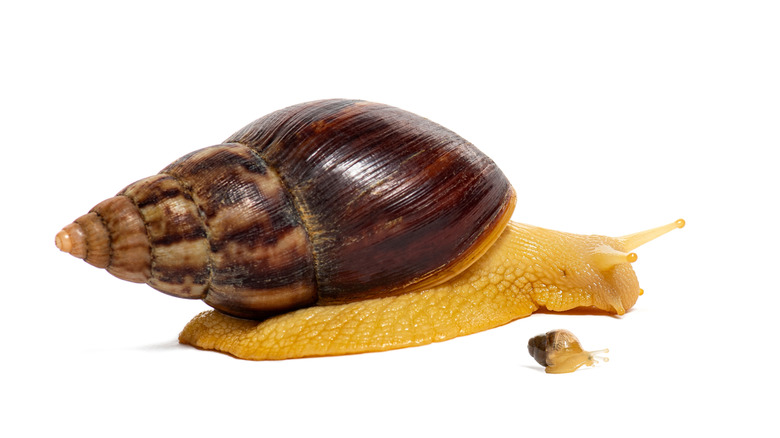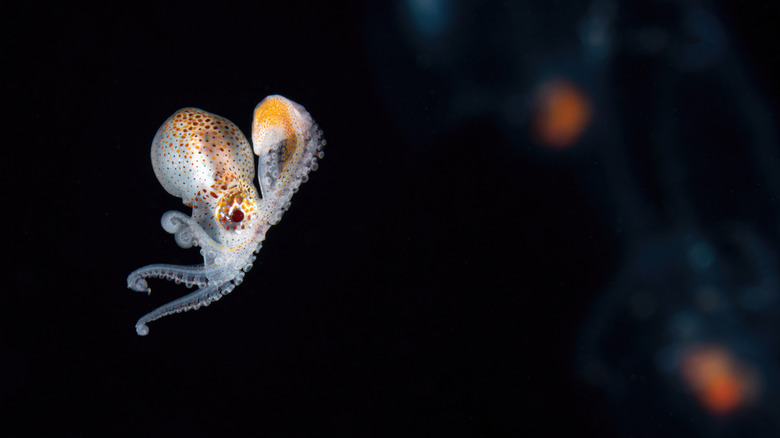Yes, Baby Snails Do Have Shells. Here's What They Look Like
Snails have shells the moment they're born, but it's kind of hard to tell. In fact, it's hard to even see a baby snail. Some are nearly microscopic, such as Angustopila psammion, whose adult-sized shell is less than half a millimeter across and whose egg is the size of a grain of sand. And to make baby snail shells even harder to spot, most snails emerge from their eggs without the rich coloration that they exhibit during the adult phase of their life. Instead, baby snail bodies and shells are often transparent. Blink and you'll miss them.
However, it's important not to generalize, especially when talking about an animal that comprises around 40,000 to 60,000 unique species. Some of those species are newly discovered, such as Figuladra robertirwini, a banded snail named after Robert Irwin. Others are well-studied household names, such as the common garden snail. Furthermore, the word "snail" isn't exactly a rigorous taxonomic term. Biologists bunch slugs and snails together in the taxonomic class Gastropoda, which is often referred to as simply the "slugs and snails class." Thus, from the perspective of a taxonomist, the only significant difference between a "snail" and a "slug" is the presence of that characteristic shell.
But the line between a slug and a snail is hazy. Because all terrestrial slugs evolved from shelled ancestors, most still retain intermediate shells. For example, some gastropod species grow cramped shells that are too small for the creature to retract its body into, such as the aptly-named semi-slugs. There are even slugs that have tiny internal shells, which are, for the most part, vestigial structures. Thus, to see baby snail shells, we'll have to narrow down the definition to only include those terrestrial creatures that can still fully retract into their shells.
How baby snail shells grow into adult snail shells
Unlike opportunist shell-residents like hermit crabs, snails grow their own shells. As a snail's body grows in size, it adds new material to the opening of the shell. That's why the whorls, or spirals, of a snail shell start at a tiny middle point, while the hole from which the snail's head emerges is typically the widest part of the shell. In other words, rather than expanding the walls of their shells outwards to accommodate their growing bodies, snails grow their shells forward.
But such shell growth must start somewhere. A baby land snail emerges from its egg with an embryonic shell called a protoconch. The protoconch is kind of like a seed; it forms the foundation from which the adult structures of the shell eventually grow. Some species' protoconches already have multiple whorls, while others have none, similar to other animals in the Mollusca phylum. However, unlike adult snail shells, the protoconch typically lacks much pigment and is often quite soft — but not for long.
As soon as they're born, baby snails start seeking calcium-rich foods to strengthen their shells. That's why a baby snail's first meal is often the very eggshell they emerged from. You'll also find newborn snails gnawing away on old bones, rocks, soil, and even other snails. The calcium they consume is ionized by their shell-building organ (the mantle) and transported to the aperture of their protoconch to start building a proper mobile home. With just a small amount of protein and a lot of calcium, baby snails quickly grow hard shells within a couple of days. And, just like other mollusks, many snails start their lives with their protoconch already spiraling in a characteristic whorl.
Other baby mollusks have adorable tiny shells, too
Snails and slugs make up the class Gastropoda, which is one of the seven classes in the Mollusca phylum. It's a diverse phylum, as it includes the nautilus, octopus, squid, sea snails, and the great variety of clam species. But all mollusks likely evolved from a single common ancestor, called the "hypothetical ancestral mollusk." Such a creature would have had certain features that all living mollusks share today. For one, all mollusks have a mantle, the organ from which snails' shells grow. Also, all mollusks have a soft, moist body, since the hypothetical ancestral mollusk originated in the oceans. When snail ancestors evolved for life on land, they adapted by growing hard, watertight shells to protect their soft, moist bodies.
But snails aren't the only mollusks that grow shells. Nautiluses grow their shell while they're still in the egg, and not just for protection. Their shells are critical for locomotion, since they house pockets of gas that help maintain buoyancy. Even many of the mollusks we eat have shells at birth. When oysters are born, their shells harden within 12 hours, eventually weighing them down and forcing them to a static life of filter-feeding. Scallops follow the same process, though their shell structures allow them to move around the ocean floor. Oysters, scallops, and clams are all members of the Bivalvia class, since they produce their shells in two distinct halves that can open and close.
Other mollusks never form a shell. For instance, octopuses are completely soft-bodied and shell-less, while squids have internal shell remnants. Nonetheless, octopuses and snails share a not-so-ancient common ancestor, so the shell is just one aspect of the larger evolutionary story shared by squishy mollusks.


